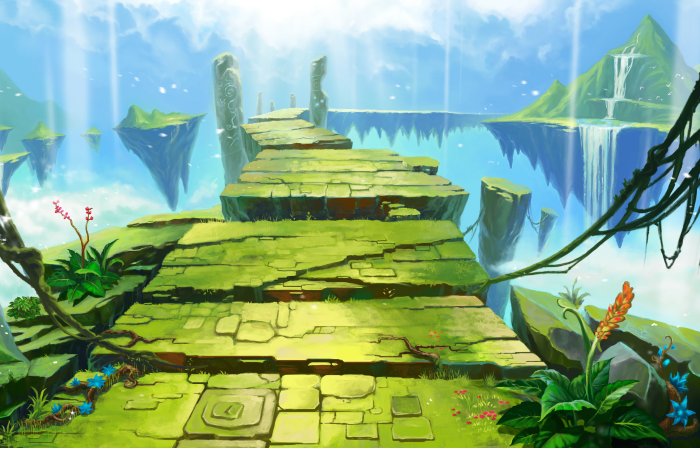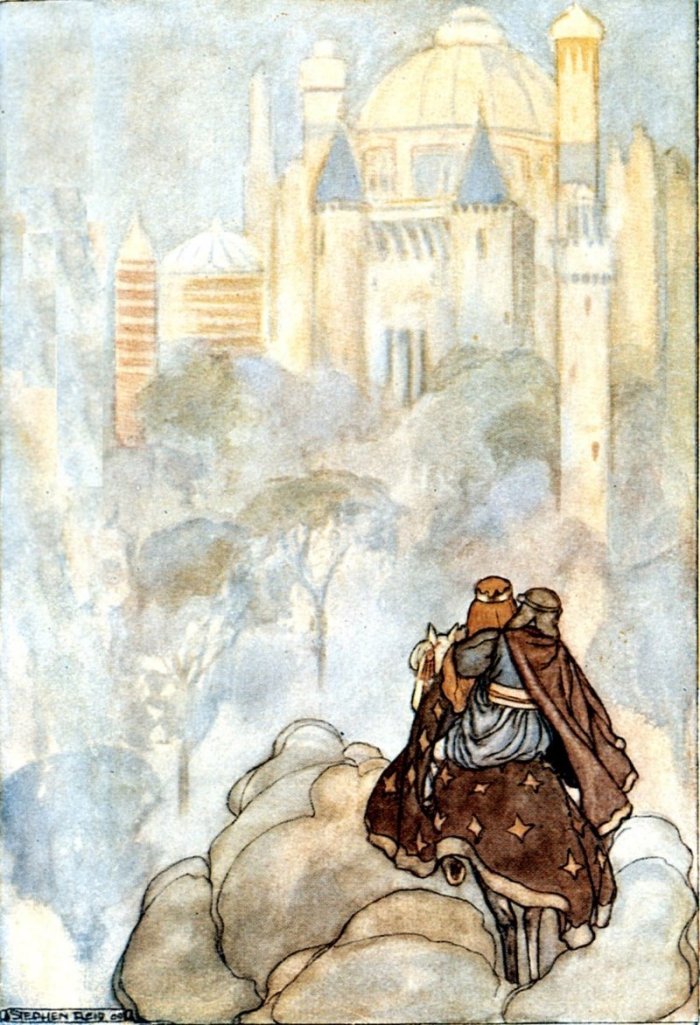Tír na nÓg – Mythical Land Where Time Floats Slower Than In Mortal Lands
A. Sutherland—AncientPages.com—In Celtic and, especially, Irish mythology, Tir na n'Og is a realm of the afterlife and one of the Happy Islands known from legends.
The 'Land of the Forever Young' was often identified as an underground realm or a mysterious land beneath the sea.
Tir na nOg - mythical realm of the afterlife. Credit. Adobe Stock - Konstantin Gerasimov
The inhabitants of this magical place would remain forever young and happy. Nobody wanted food or drink, and illness, ugliness, and death did not have access to Tir na n'Og.
Floating Time On Magical Tir na nÓg Island
As on other Happy Islands also on Tír na nÓg, the time flows slower than in the land of mortals.
Legend says that "one year on earth equals one minute in Tir na nÓg. It would explain how the beings of similar otherworlds in other ancient traditions could have an almost unimaginable life span.
On Tír na nÓg, the suspension of the aging process takes place for all who dwell there, and it's undoubtedly the most prominent quality of this realm of the afterlife.
In the early saga 'The Adventure of Nera' (Echtrae Nerai), about a warrior of Connacht in the Ulster Cycle, it is written that: "it is within the world you have left, as an apple is within its skin, and all who die in your world come to this one. But within this world is another called the 'Land of Wonders,' and those who die here, or who can wish to do so, go to the Land of Wonders.
Within the Land of Wonders, there is yet a world called the 'Land of Promise,' and those who die in the Land of Wonders are born into the Land of Promise, but they cannot die there until they can wish to do so…"
Oisin's Visit In The Land Of Youth
In the 'Song of Oisín in the Land of Youth' (Laoi Oisín and Tir na nÓg) dominates a wealth of riches, a never-ending spring, and sumptuous feasts accompanied by excellent music.
As we remember, a similar place was also the Elysian Fields in Greek beliefs, and Valhalla in Norse mythology was also a paradise-like place for warriors.
According to an enchanting ancient legend, the most famous human visitor to Tir na n'Og was the legendary Celtic poet and the greatest poet of Ireland, Oisin. Oisin (Ossian) was the son of Fionn Mac Cumhail, a legendary Irish hero, clairvoyant, and leader of Fianna warriors.
Occasionally mortal men were invited to Tir Nan Og, and Oisin (Ossian) was one of them.
In Scottish tradition, Oisin went into a síd or to Tír na nÓg ("the Land of Youth"), where he met a pretty woman who said, "Will you not go with your mother?"
Then she opened a door in the rock, and Oisin remained with her for centuries, although it seemed only a week. But when he wished to return to the land of mortals, she told him that none of them was left.
In an Irish version, on the other hand, Oisin entered a cave and there saw a woman, also gorgeous (but not his mother). Her name was Niamh, and she was the daughter of the King of Tir na nÓg. Oisin spent three hundred years there, although, for a mortal Oisín, this long time passed like just a few days.
Oisín and Niamh travelling to Tír na nÓg, illustration by Stephen Reid in T. W. Rolleston's The High Deeds of Finn (1910). STEPHEN REID - THE HIGH DEEDS OF FINN AND OTHER BARDIC ROMANCES OF ANCIENT IRELAND BY T. W. ROLLESTON, illustrated by STEPHEN REID http://www.gutenberg.org/files/14749/14749-h/14749-h.htm#IL16
He was happy in "the Land of Youth" but not entirely because he longed for home. Niamh gave him a magical white steed and warned him not to dismount the animal, but on his way home, Oisin met men trying to lift a marble flagstone. They asked appealed to him for aid, and stooping from his horse, he raised the stone; but as he did so, his foot touched the ground, whereupon his horse vanished, and he found himself a worn, blind old man... " 1
Sidhe And Festival Of Samhain
The ancient Celtic festival of Samhain was celebrated 2,000 years ago in the areas now known as Ireland, the United Kingdom, and northern France. People who lived in early medieval Ireland believed that during the festival, "the earth-bound spirits were briefly free to leave the sídhe ("mounds"). Otherwise, they lived underground in fairy mounds or an invisible world that coexists with the world of humans. In this understanding of cosmology, the sídhe are the entrance places to Tír na nÓg. Still, they also mean supernatural creatures in Scottish and Irish myths, similar to the fairies or elves but quite different from humans.
In the Book of Invasion, this world is described as a parallel universe, in which the sidhe walk amongst the living. Later, the hills and the people inhabiting them became known as sídhe. Among many Celtic traditions, also in Scotland, there was an ancient belief originating from the Irish mythology of the Tuatha Dé Danann living in Tír na nÓg that this wonderful world was entered through prehistoric mounds. These Irish underground homes were the fairy sídhe.
Otherwise, hillsides and ancient burial mounds were associated with the "little people" dancing and living under them.
Written by – A. Sutherland - AncientPages.com Senior Staff Writer
Updated on March 18, 2024
Copyright © AncientPages.com All rights reserved. This material may not be published, broadcast, rewritten or redistributed in whole or part without the express written permission of AncientPages.com
Expand for referencesReferences:
- MacCulloch, John Arnott. Celtic Mythology (pp. 180-181).
More From Ancient Pages
-
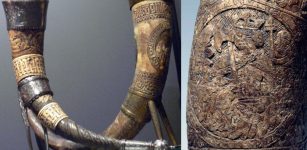 Ancient Icelandic Drinking Horn Reveals An Interesting Story About Saint-King Olaf
Ancient Traditions And Customs | Mar 29, 2017
Ancient Icelandic Drinking Horn Reveals An Interesting Story About Saint-King Olaf
Ancient Traditions And Customs | Mar 29, 2017 -
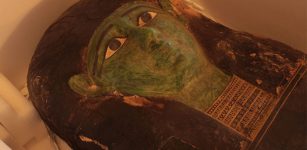 Looted Green Coffin Of Ancient Egyptian Priest Returned To Egypt From US
Archaeology | Jan 2, 2023
Looted Green Coffin Of Ancient Egyptian Priest Returned To Egypt From US
Archaeology | Jan 2, 2023 -
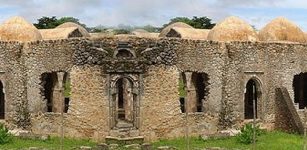 Ancient Ruins Of Kilwa Kisiwani And Songo Mnara: Great African Ports Long Abandoned And Forgotten
Civilizations | Nov 21, 2018
Ancient Ruins Of Kilwa Kisiwani And Songo Mnara: Great African Ports Long Abandoned And Forgotten
Civilizations | Nov 21, 2018 -
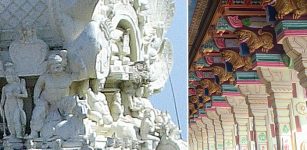 Ramanathaswamy Temple Has Spectacular Corridors With Over 4000 Pillars
Featured Stories | Jun 9, 2021
Ramanathaswamy Temple Has Spectacular Corridors With Over 4000 Pillars
Featured Stories | Jun 9, 2021 -
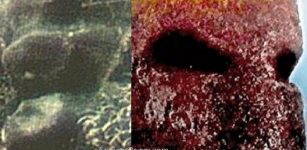 Prehistoric Puzzle: Three Gigantic Stone Heads Of Unknown Origin
Featured Stories | Mar 17, 2020
Prehistoric Puzzle: Three Gigantic Stone Heads Of Unknown Origin
Featured Stories | Mar 17, 2020 -
 Scipio Africanus – Rome’s Greatest General Who Defeated Unbeatable Hannibal
Featured Stories | Aug 5, 2021
Scipio Africanus – Rome’s Greatest General Who Defeated Unbeatable Hannibal
Featured Stories | Aug 5, 2021 -
 How Human Ancestors Used Fire – New Methods Give Answers
Archaeology | Nov 2, 2022
How Human Ancestors Used Fire – New Methods Give Answers
Archaeology | Nov 2, 2022 -
 Viking Longships: Fearless Dragonships Daring The Oceans And Seas
Ancient History Facts | Apr 16, 2016
Viking Longships: Fearless Dragonships Daring The Oceans And Seas
Ancient History Facts | Apr 16, 2016 -
 7,000-Year-Old Ibex Remains Found Under The Ice In Italy Are 1,700 Years Older Than Ötzi!
Archaeology | Dec 14, 2022
7,000-Year-Old Ibex Remains Found Under The Ice In Italy Are 1,700 Years Older Than Ötzi!
Archaeology | Dec 14, 2022 -
 Brilliant Prehistoric Cave Paintings Of Lascaux – Who Were Their Unknown Creators?
Civilizations | Jun 2, 2014
Brilliant Prehistoric Cave Paintings Of Lascaux – Who Were Their Unknown Creators?
Civilizations | Jun 2, 2014 -
 Mystery Of Vangchhia Ancient Site: Water Pavilion And Ingenious Idea Of Water Harvesting
Archaeology | Feb 21, 2019
Mystery Of Vangchhia Ancient Site: Water Pavilion And Ingenious Idea Of Water Harvesting
Archaeology | Feb 21, 2019 -
 New Clues To Behavior Of Neanderthal Hunting Parties
Archaeology | Mar 27, 2023
New Clues To Behavior Of Neanderthal Hunting Parties
Archaeology | Mar 27, 2023 -
 Advent: Facts And History About The Christian Season Celebration
Ancient Traditions And Customs | Dec 1, 2023
Advent: Facts And History About The Christian Season Celebration
Ancient Traditions And Customs | Dec 1, 2023 -
 Very Rare Ancient Roman Horse Brooch Discovered In UK
Archaeology | Mar 7, 2020
Very Rare Ancient Roman Horse Brooch Discovered In UK
Archaeology | Mar 7, 2020 -
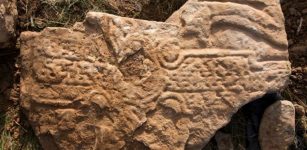 Enigmatic Stones Of The Picts: Orkney’s Unique Stone With Dragon-Like Creature And Cross Carving
Civilizations | Oct 19, 2018
Enigmatic Stones Of The Picts: Orkney’s Unique Stone With Dragon-Like Creature And Cross Carving
Civilizations | Oct 19, 2018 -
 Scathach – The Shadowy One – Legendary Martial Arts Teacher Who Trained Cuchulainn And Other Warriors
Featured Stories | Mar 4, 2019
Scathach – The Shadowy One – Legendary Martial Arts Teacher Who Trained Cuchulainn And Other Warriors
Featured Stories | Mar 4, 2019 -
 Bizarre And Unexplained Phenomenon That Defied The Laws Of Nature
Featured Stories | May 12, 2018
Bizarre And Unexplained Phenomenon That Defied The Laws Of Nature
Featured Stories | May 12, 2018 -
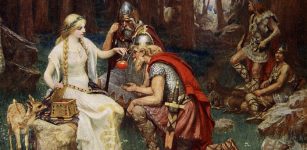 The Golden Apple Myth And Norse Goddess Idun
Featured Stories | Jan 2, 2016
The Golden Apple Myth And Norse Goddess Idun
Featured Stories | Jan 2, 2016 -
 Still Intact Renaissance Shipwreck Discovered On The Baltic Seabed
Archaeology | Jul 24, 2019
Still Intact Renaissance Shipwreck Discovered On The Baltic Seabed
Archaeology | Jul 24, 2019 -
 Strange And Scary Encounter With Ancient Giants In North America
Featured Stories | Sep 23, 2021
Strange And Scary Encounter With Ancient Giants In North America
Featured Stories | Sep 23, 2021

